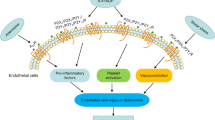Summary
Endothelium-derived relaxing factor is a potent endogenous vasodilator. This substance is now known to be nitric oxide, which is derived from the metabolism of L-arginine. This potent vasodilator also inhibits interactions of circulating blood elements with the vessel wall. Platelet adherence and aggregation, as well as monocyte adherence and infiltration, are regulated by this paracrine factor. By virtue of these characteristics, nitric oxide inhibits atherogenesis.
Similar content being viewed by others
References
Ross R. The pathogenesis of atherosclerosis. N Engl J Med 1986; 314: 488–500
Cybulsky MI, Gimbrone Jr MA. Endothelial expression of a mononuclear leukocyte adhesion molecule during atherogenesis. Science 1991; 251: 788–91
Berliner JA, Navab M, Fogelman AM, et al. Atherosclerosis: basic mechanisms. Oxidation, inflammation, and genetics. Circulation 1995; 91: 2488–96
Parhami F, Morrow AD, Balucan J, et al. Lipid oxidation products have opposite effects on calcifying vascular cell and bone cell differentiation. A possible explanation for the paradox of arterial calcification in osteoporotic patients. Arterioscler Thromb Vasc Biol 1997; 17: 680–7
Knox JB, Sukhova GK, Whittemore AD, et al. Evidence for altered balance between matrix metalloproteinases and their inhibitors in human aortic disease. Circulation 1997; 95: 205–12
European Working Group on Critical Leg Ischemia: second European consensus document on chronic critical leg ischemia. Circulation 1991; 84 Suppl. 4: IV-–1–IV-–26
Cooke JP, Candipan R. Vascular biology of restenosis: insights for therapeutic strategies. J Intervent Cardiol 1994; 6: 25–35
Moncada S, Higgs EA. Molecular mechanisms and therapeutic strategies related to nitric oxide. FASEB J 1995; 9: 1319–30
Cohen RA. The role of nitric oxide and other endothelium-derived vasoactive substances in vascular disease. Prog Cardiovasc Dis 1995; XXXVIII(2): 105–28
Kubes P, Suzuki M, Granger DN. Nitric oxide: an endogenous modulator of leukocyte adhesion. Proc Natl Acad Sci USA 1991; 88: 4651–85
Johnson III G, Tsao PS, Mulloy D, et al. Cardioprotective effects of acidified sodium nitrite in myocardial ischemia with reperfusion. J Pharmacol Exp Ther 1990; 252: 35–41
Bath PMW, Hassall DG, Gladwin A-M, et al. Nitric oxide and prostacyclin. Divergence of inhibitory effects on monocyte chemotaxis and adhesion to endothelium in vitro. Arterioscler Thromb 1991; 11: 254–60
Tsao PS, Lewis NP, Alpert S, et al. Exposure to shear stress alters endothelial adhesiveness: role of nitric oxide. Circulation 1995; 92: 3513–9
Zeiher AM, Fisslthaler B, Schray-Utz B, et al. Nitric oxide modulates expression of monocyte chemoattractant protein-a in cultured human endothelial cells. Circ Res 1995; 76: 980–6
Tsao PS, Buitrago R, Chan JR, et al. Fluid flow inhibits endothelial adhesiveness: nitric oxide and transcriptional regulation of VCAM-1. Circulation 1996; 94: 1682–9
Tsao PS, Wang BY, Buitrago R, et al. Nitric oxide regulates monocyte chemotactic protein-1. Circulation 1997; 96: 934–40
Peng HB, Libby P, Liao JK. Induction and stabilisation of 1 kappa B alpha by nitric oxide mediates inhibition of NF-kappa B. J Biol Chem 1995; 270: 14214–9
Garg UC, Hassid A. Nitric oxide-generating vasodilators and 8-bromocyclic guanosine monophosphate inhibit nitrogenesis and proliferation of cultured rat vascular smooth muscle cells. J Clin Invest 1989; 83: 1774–7
Wang BY, Candipan RC, Arjomandi M, et al. Arginine restores NO activity and inhibits monocyte accumulation after vascular injury in hypercholesterolemic rabbits. J Am Coll Cardiol 1996; 28: 1573–9
von der Leyen HE, Gibbons GH, Morishita R, et al. Gene therapy inhibiting neointimal vascular lesion: in vivo transfer of endothelial cell nitric oxide synthase gene. Proc Natl Acad Sci USA 1995; 92: 1137–41
Schwarzacher SP, Lim TT, Wang BY, et al. Local intramural delivery of L-arginine enhances nitric oxide generation and inhibits lesion formation after balloon angioplasty. Circulation 1997; 95: 1863–9
Cooke JP, Tsao PS. Cytoprotective effects of nitric oxide. Circulation 1993; 88: 2151–4
Cooke JP, Andon NA, Girerd XJ, et al. Arginine restores cholinergic relaxation of hypercholesterolemic rabbit thoracic aorta. Circulation 1991; 83: 1057–62
Cooke JP, Dzau VJ. Derangements of the nitric oxide synthase pathway, L-arginine, and cardiovascular disease [editorial]. Circulation 1997; 95: 379–82
Cooke JP, Singer AH, Tsao P, et al. Anti-atherogenic effects of L-arginine in the hypercholesterolemic rabbit. J Clin Invest 1992; 90: 1168–72
Wang B, Singer A, Tsao P, et al. Dietary arginine prevents atherogenesis in the coronary artery of the hypercholesterolemic rabbit. J Am Coll Cardiol 1994; 23: 452–8
Tsao P, McEvoy LM, Drexler H, et al. Enhanced endothelial adhesiveness in hypercholesterolemia is attenuated by L-arginine. Circulation 1994; 89: 2176–82
Candipan RC, Wang B, Buitrago R, et al. Regression or progression: dependency upon vascular nitric oxide. Arterioscler Thromb Vasc Biol 1996; 16: 44–50
Ohara Y, Petersen TE, Harrison DG. Hypercholesterolemia increases endothelial Superoxide anion production. J Clin Invest 1993; 91: 2546–51
Marui N, Offerman MK, Swerlick R, et al. Vascular cell adhesion molecule-1 (VCAM-1) gene transcription and expression are regulated through an antioxidant-sensitive mechanism in human vascular endothelial cells. J Clin Invest 1993; 92: 1866–72
Author information
Authors and Affiliations
Rights and permissions
About this article
Cite this article
Cooke, J.P., Bhatnagar, R. Pathophysiology of Atherosclerotic Vascular Disease. Dis-Manage-Health-Outcomes 2 (Suppl 1), 1–8 (1997). https://doi.org/10.2165/00115677-199700021-00003
Published:
Issue Date:
DOI: https://doi.org/10.2165/00115677-199700021-00003




